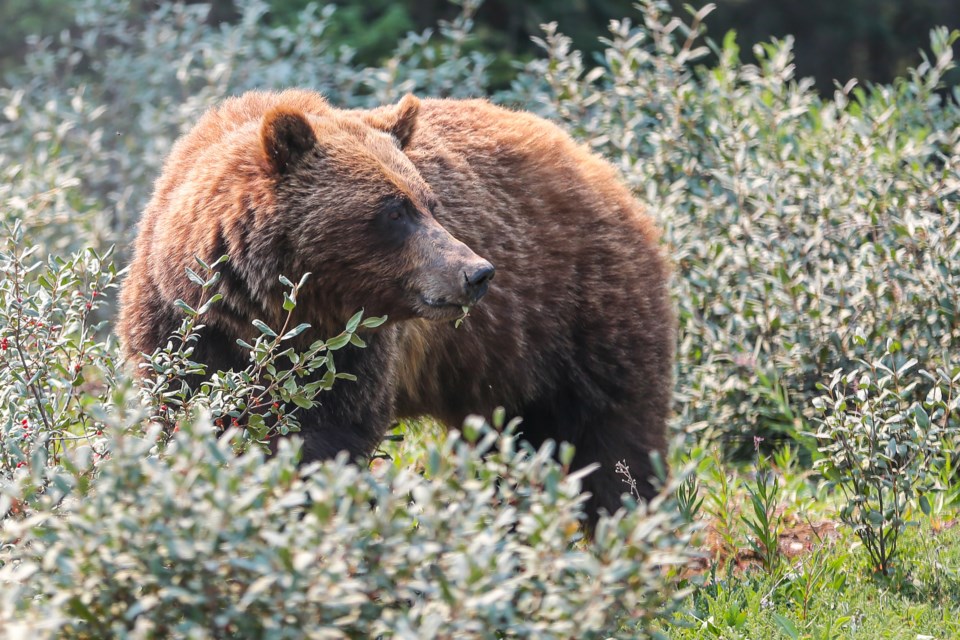BOW VALLEY – This year’s buffaloberry crop is ripening earlier and is expected to last longer than recent years in Banff, Yoho and Kootenay national parks, according to a Parks Canada advisory.
The advisory, which began June 30 and is expected to last until the end of September, urges residents and visitors to be alert while bears focus on fattening up on the calorie-rich berry for winter.
“The seasonal advisory is typically in place from late July to early August,” said Dylan Spencer, resource conservation manager for the Banff National Park field unit. “It was implemented two weeks earlier than previous years just due to the early warm temperatures, which allowed the berries to ripen quite a bit earlier this year.”
Buffaloberries – also known as shepherdia – are a vital food source for bears. A large male grizzly can eat up to 200,000 a day, feasting around the clock to prepare for hibernation.
Parks Canada monitors the buffaloberry crop, which varies from year-to-year. This year, the mountain national parks indicate an above average yield.
“Recent assessments of front country berry crops show that some plants are fully ripened, and others have green berries still and have yet to ripen,” said Spencer. “So, it’s expected there’ll be a range in berry ripeness that may also extend the length of time that berries are accessible before they drop.”
Compared to a poor berry crop the last two years, Spencer said this year looks to be a welcome change for bears.
When the berry crop fails, bears must forage more widely and expend more energy. With fewer food options and wider travels, food-stressed bears are more likely to get into improperly stored wildlife attractants, like garbage. Sows denning leaner than normal in the fall may also emerge in the spring with fewer or smaller cubs.
A good berry crop is great news for bears, but it also means the public must be vigilant as more encounters with the animal are likely, said Nick de Ruyter, director of Bow Valley WildSmart.
“Everywhere we go is where the berries like to grow,” he said. “We often use those areas where the berries are the best.”
Buffaloberry brushes are often found near trails, roads, railroad tracks and campgrounds where there is adequate sunlight to grow, but can be found throughout the three mountain national parks and in the Bow Valley at low and high elevations.
In Banff National Park and Kananaskis Country, where visitors average four million per year, bear encounters are inevitable. Berries grow and bears are also known to roam around Bow Valley communities like Canmore, Exshaw and Dead Man’s Flats.
Numerous bear warnings are in place throughout the area, including Mount Lorette Ponds day use area, Paddy's Flat Campground and others, due to bears feeding on berries.
“The key thing with berry season is people need to expect to see bears,” said de Ruyter. “It doesn’t mean it’s 100 per cent going to happen, but mentally you need to be prepared and expect encounters so that you’re not surprised, or surprising a bear.”
A bear focused on feeding is easy to surprise as it’s not as likely to be aware of its surroundings, including the presence of people.
In addition to carrying bear spray and knowing how to use it, keeping dogs leashed or leaving them at home and travelling in groups, de Ruyter stressed the importance of making plenty of noise when hiking or biking on trails in bear country.
“We need to be making lots of noise,” he said. “It’s always good to travel in a group ideally, but also stay together as a group so you’re more intimidating to a bear and can make more noise.”
Parks Canada and WildSmart also remind visitors to avoid wearing earbuds while on trails and watch for fresh bear signs such as tracks and scat to avoid encounters.
“If you see a fresh pile of scat, that means there’s a bear in the area so either make more noise and be extra alert and get your bear spray ready, or consider turning around and finding another way,” said de Ruyter.
All bear sightings should be reported to 403-762-1470. WildSmart’s weekly bear activity report can also be found on the Biosphere of the Bow Valley’s website: www.biosphereinstitute.org/bear-report.
For information on bear warnings and closures in Kananaskis Country visit www.albertaparks.ca/albertaparksca/advisories-public-safety, for Banff, Yoho and Kootenay national parks visit www.parks.canada.ca/voyage-travel/securite-safety/important-bulletins-importants.
The Local Journalism Initiative is funded by the Government of Canada. The position covers Îyârhe (Stoney) Nakoda First Nation and Kananaskis Country.




